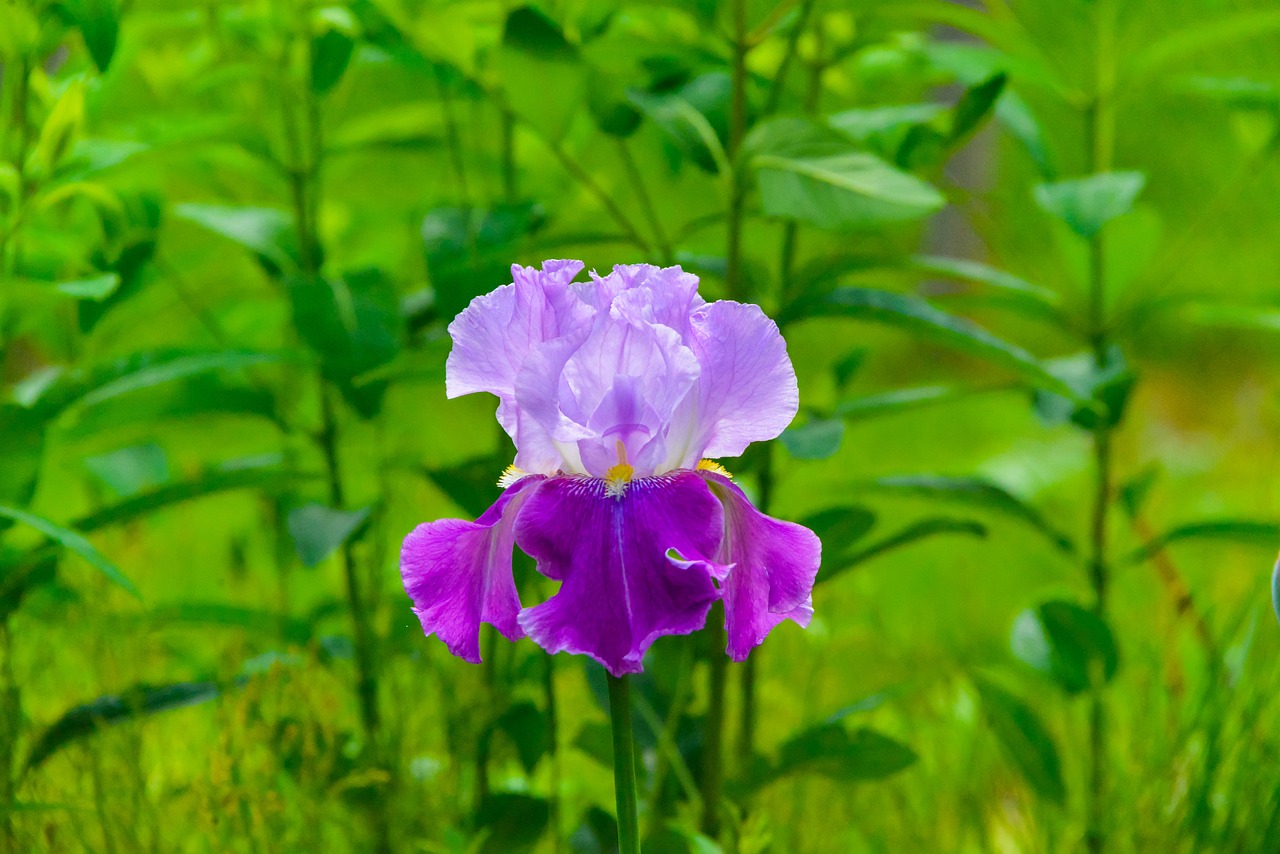Are you ready to dive into the world of iris gardening? In this article, we will walk you through the essential steps to successfully grow and care for your iris plants. Whether you’re a beginner or an experienced gardener, these tips and guidance will help you keep your irises healthy and vibrant.
Let’s start with planting. Choosing the right location is crucial for the growth and development of your irises. Make sure to find an ideal spot that receives plenty of sunlight and has well-draining soil. Irises thrive in full sun, so find a sunny spot in your garden to plant them. Additionally, ensure that the soil is loose, fertile, and well-drained.
Once you have selected the perfect location, it’s time to plant your iris bulbs. Dig a hole that is wide and deep enough to accommodate the roots of the bulb. Place the bulb in the hole, making sure that the pointed end is facing upwards. Gently cover the bulb with soil and pat it down to remove any air pockets. Water the newly planted iris thoroughly, and continue to provide regular watering to keep the soil moist but not waterlogged.
Proper watering is crucial for the health of your irises. They require regular watering, especially during dry spells or hot summer months. However, be cautious not to overwater them, as excessive moisture can lead to root rot. A good rule of thumb is to water deeply once a week, allowing the soil to dry out slightly between waterings.
Now that you have planted your irises and provided them with the necessary water, it’s time to focus on maintenance. Regular fertilization is important to keep your irises thriving. Use a balanced fertilizer specifically formulated for flowering plants, and apply it according to the manufacturer’s instructions. This will provide the necessary nutrients for healthy growth and vibrant blooms.
Additionally, it’s essential to keep an eye out for pests and diseases that can affect your irises. Common pests include aphids, slugs, and iris borers. Regularly inspect your plants for any signs of infestation and take appropriate measures to control them. Similarly, keep an eye out for any signs of diseases such as leaf spot or iris rot, and promptly address them to prevent further damage.
By following these essential steps and providing proper care, you can enjoy a beautiful and thriving iris garden. From planting to maintenance, these tips and guidance will help you create a vibrant and healthy environment for your irises to flourish.
Choosing the Right Location
When it comes to planting your iris, selecting the right location is crucial for their growth and overall health. Irises thrive in areas that receive ample sunlight, so it’s important to choose a spot that gets at least six hours of direct sunlight per day. This will ensure that your irises can photosynthesize and produce the energy they need to flourish.
In addition to sunlight, irises also require well-draining soil. They prefer soil that is slightly acidic with a pH level between 6.0 and 7.0. If your soil is heavy or clay-like, you can improve its drainage by adding organic matter such as compost or peat moss. This will help create a suitable environment for your irises to thrive.
To summarize, when choosing the right location for your iris, make sure it receives adequate sunlight and has well-draining soil with a slightly acidic pH level. By providing these ideal conditions, you are setting the stage for your irises to grow and flourish.
Planting and Watering
When it comes to planting iris bulbs, it’s essential to follow the proper techniques to ensure their successful growth. Start by selecting a location that receives at least 6 hours of sunlight per day. Irises thrive in well-drained soil, so make sure to prepare the soil by loosening it and adding organic matter.
Next, dig a hole that is wide and deep enough to accommodate the iris bulb. Place the bulb in the hole with the pointed end facing upwards and cover it with soil, gently pressing it down. Water the newly planted bulb thoroughly to help settle the soil and provide moisture.
Proper irrigation is crucial for the health of your iris plants. They require regular watering, especially during dry periods. However, it’s important to avoid overwatering as it can lead to root rot and other issues. To determine if your irises need watering, check the soil moisture level by inserting your finger into the soil. If it feels dry, it’s time to water.
One common mistake to avoid is watering the foliage of the iris plants. This can promote the growth of fungal diseases. Instead, focus on watering the soil around the plants, ensuring that the water reaches the roots. Consider using a soaker hose or drip irrigation system to provide a slow, steady supply of water directly to the roots.
By following these proper planting and watering techniques, you can ensure that your iris bulbs receive the necessary moisture and create a favorable environment for their growth.
Dividing and Transplanting
Dividing and transplanting iris plants is a crucial step in promoting their growth and ensuring their overall health. By dividing the plants, you can prevent overcrowding and encourage the development of new rhizomes. This process also allows you to propagate your iris collection and create new plants.
Knowing when to divide your irises is essential. Typically, it is best to divide them every three to five years, preferably in late summer or early fall when the plants are dormant. This timing gives the transplanted irises enough time to establish their root systems before the arrival of winter.
To divide your irises, start by carefully digging up the entire clump of plants. Gently separate the rhizomes, ensuring that each division has healthy roots and at least one fan of leaves. Trim any damaged or diseased parts before replanting.
When transplanting the divided irises, choose a well-draining location with fertile soil and ample sunlight. Dig a hole large enough to accommodate the rhizome and its roots, making sure to position it horizontally just below the soil surface. Water the newly transplanted irises thoroughly to help them settle in their new environment.
Remember to space the divisions adequately to allow room for future growth. Regularly monitor the transplants for signs of stress or disease and provide them with proper care, including regular watering and fertilization. With the right techniques, dividing and transplanting your iris plants can result in a flourishing and vibrant garden.
Pruning and Deadheading
Discover the benefits of pruning and deadheading iris plants to enhance their appearance and encourage new growth. Pruning is an essential practice that helps maintain the health and shape of your iris plants. By removing dead or damaged leaves and stems, you create space for new growth and prevent the spread of diseases. Deadheading, on the other hand, involves removing spent blooms to redirect the plant’s energy towards producing new flowers.
To prune your iris plants, start by removing any dead or yellowing leaves. Use clean and sharp pruning shears to make clean cuts at the base of the plant. Be sure to remove any diseased or damaged foliage to prevent the spread of infections. Additionally, thin out crowded areas by cutting back excess stems to allow air circulation and prevent the onset of fungal diseases.
When it comes to deadheading iris plants, it’s best to remove the faded blooms as soon as they start to wither. This not only improves the overall appearance of your garden but also encourages the plant to produce more flowers. To deadhead, locate the spent bloom and trace the stem down to the first set of healthy leaves. Use your fingers or a pair of scissors to cut the stem just above this set of leaves. By doing so, you prevent the formation of seed pods and redirect the plant’s energy towards new growth.
Regular pruning and deadheading will help keep your iris plants looking their best and promote healthy growth. Remember to clean your tools after each use to prevent the spread of diseases. With proper care, your irises will reward you with stunning blooms year after year.
Pest and Disease Control
When it comes to growing and caring for your iris plants, it’s important to be aware of the potential pests and diseases that can affect them. By learning how to identify and address these issues, you can ensure that your irises remain healthy and free from damage.
One common pest that can wreak havoc on iris plants is the iris borer. These destructive insects lay their eggs on the iris leaves, and the larvae then burrow into the plant, causing damage to the rhizomes. To prevent infestation, regularly inspect your irises for any signs of eggs or larvae, and promptly remove and destroy any affected leaves.
In addition to pests, iris plants are also susceptible to various diseases such as bacterial soft rot and fungal leaf spot. To prevent the spread of these diseases, it’s important to practice good sanitation in your garden. This includes removing and disposing of any infected plant material, avoiding overhead watering, and providing adequate air circulation around the plants.
If you do encounter pest or disease issues with your iris plants, there are treatment options available. For pests, you can use insecticidal sprays or dusts specifically formulated for iris borers. When it comes to diseases, there are fungicides that can help control fungal infections. However, it’s important to carefully follow the instructions on the product labels and use these treatments as a last resort.
By being proactive in identifying and addressing pest and disease issues, you can keep your irises healthy and vibrant, ensuring they continue to bring beauty to your garden for years to come.
Frequently Asked Questions
- Q: How often should I water my iris plants?
A: Iris plants should be watered regularly, especially during dry periods. It is important to keep the soil consistently moist but not waterlogged. Water deeply once a week, ensuring that the water reaches the roots. Avoid overwatering as it can lead to root rot.
- Q: When is the best time to divide iris plants?
A: The best time to divide iris plants is usually in late summer or early fall, after they have finished blooming. Dividing them every 3-4 years helps prevent overcrowding and promotes healthier growth. Make sure to replant the divisions promptly to minimize stress on the plants.
- Q: How can I protect my irises from pests and diseases?
A: To protect your irises from pests and diseases, maintain good garden hygiene by removing any dead or decaying plant material. Keep an eye out for common pests like iris borers and aphids, and promptly address any signs of infestation. Applying organic insecticides or using beneficial insects can also help control pests.
- Q: Can irises grow in containers or pots?
A: Yes, irises can be grown in containers or pots. Choose a container with good drainage and use a well-draining potting mix. Ensure the container receives adequate sunlight and water the plants regularly. Keep in mind that potted irises may require more frequent watering than those grown in the ground.
- Q: Do irises need full sun or can they tolerate shade?
A: Irises generally prefer full sun to thrive and produce abundant blooms. However, some varieties can tolerate partial shade. If planting in a shady location, make sure the irises still receive at least 4-6 hours of direct sunlight each day for optimal growth.


